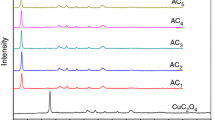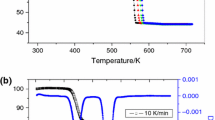Abstract
Metal formiates and oxalates applied onto HMX increase the initial rate and decrease the induction period of thermal decomposition of HMX. The activity of sodium oxalates, which contain crystal water, is much lower than that of anhydrous formiates of the same metals. The possible reasons of the catalytic effect of the additives on the thermal decomposition of are discussed.
Similar content being viewed by others
REFERENCES
H. Singh, “Combustion mechanism of nitramine based solid rocket propellants,” in: Energetic Materials — Ig-nition, Combustion, and Detonation, Proc. of the 32th Int. ICT-Conference, Karlsruhe, FRG (2001), pp. 15/1– 15/6.
T. B. Brill, “Chemistry of a burning propellant surface,” in: I. Hargittai and T. Vidoczy (eds.), Combustion Effi-ciency and Air Quality, Plenum Press, New York (1995), pp. 63–87.
A. I. Gol'binder, Laboratory Work in the Theory of Ex-plosives, [in Russian], Rosvuzizdat, Moscow (1963).
S. F. Palopoli and T. B. Brill, “Thermal decomposition of energetic materials. 27. Synthesis, characterization, and thermolysis of Cu (II)-doped Blue RDX,” Combust. Flame, 72, No. 2, 153–158 (1988).
I. V. Arkhangel'skii, L. N. Komissarova, and V. P. Fa-likman, “Interrelation between the structural character-istics and kinetic parameters of the thermal decomposi-tion of some metal formiates,” Koord. Khim., 3, No. 3, 385–394 (1977).
R. S. Stepanov and L. A. Kruglyakova, “Kinetic reg-ularities and mechanism of thermal decomposition of lead formiate,” in: All-Union Conf. on Resource Use and Recovery in the Angara–Enisei Region, Krasnoyarsk (1992), pp. 222–226.
V. V. Boldyrev, I. S. Nev'yantsev, Yu. N. Mikhailov, and E. F. Khairetdinov, “On the mechanism of thermal decomposition of oxalates,” Kinet. Katal., 11, No. 2, 367–373 (1970).
V. V. Boldyrev, Reactivity of Solids (Using Thermal De-composition as an Example) [in Russian], Izd. Sib. Otd. Akad. Nauk SSSR, Novosibirsk (1997), 106–174.
J. D. Cosgrove and A. J. Owen, “The thermal decompo-sition of 1,3,5-trinitrohexahydro-1,3,5-triazine (RDX). Part II: The effects of products,” Combust. Flame, 22, No. 1, 19–22 (1974).
F. I. Dubovitskii and B. L. Korsunskii, “Kinetics of ther-mal decomposition of N-nitrocompounds,” Usp. Khim., 50, No. 10, 1828–1871 (1981).
N. E. Ermolin and V. E. Zarko, “Mechanism and kinet-ics of the thermal decomposition of cyclical nitramines,” Combust. Expl. Shock Waves, 33, No. 3, 251–269 (1997).
R. S. Stepanov, L. A. Kruglyakova, and K. V. Pekhotin “Kinetics and mechanism of thermal decomposition of HMX with metal cupferronate additives,” Combust. Expl. Shock Waves, 35, No. 3, 261–265 (1999).
R. S. Stepanov, L. A. Kruglyakova, and K. V. Pekhotin, “Effect of propionitrile nitramine salts on the thermal decomposition of HMX,” Combust. Expl. Shock Waves, 36, No. 5, 618–621 (2000).
Author information
Authors and Affiliations
Rights and permissions
About this article
Cite this article
Stepanov, R.S., Kruglyakova, L.A., Astakhov, A.M. et al. Effect of Metal Formiates and Oxalates on HMX Decomposition. Combustion, Explosion, and Shock Waves 40, 576–579 (2004). https://doi.org/10.1023/B:CESW.0000041410.25641.cc
Issue Date:
DOI: https://doi.org/10.1023/B:CESW.0000041410.25641.cc




